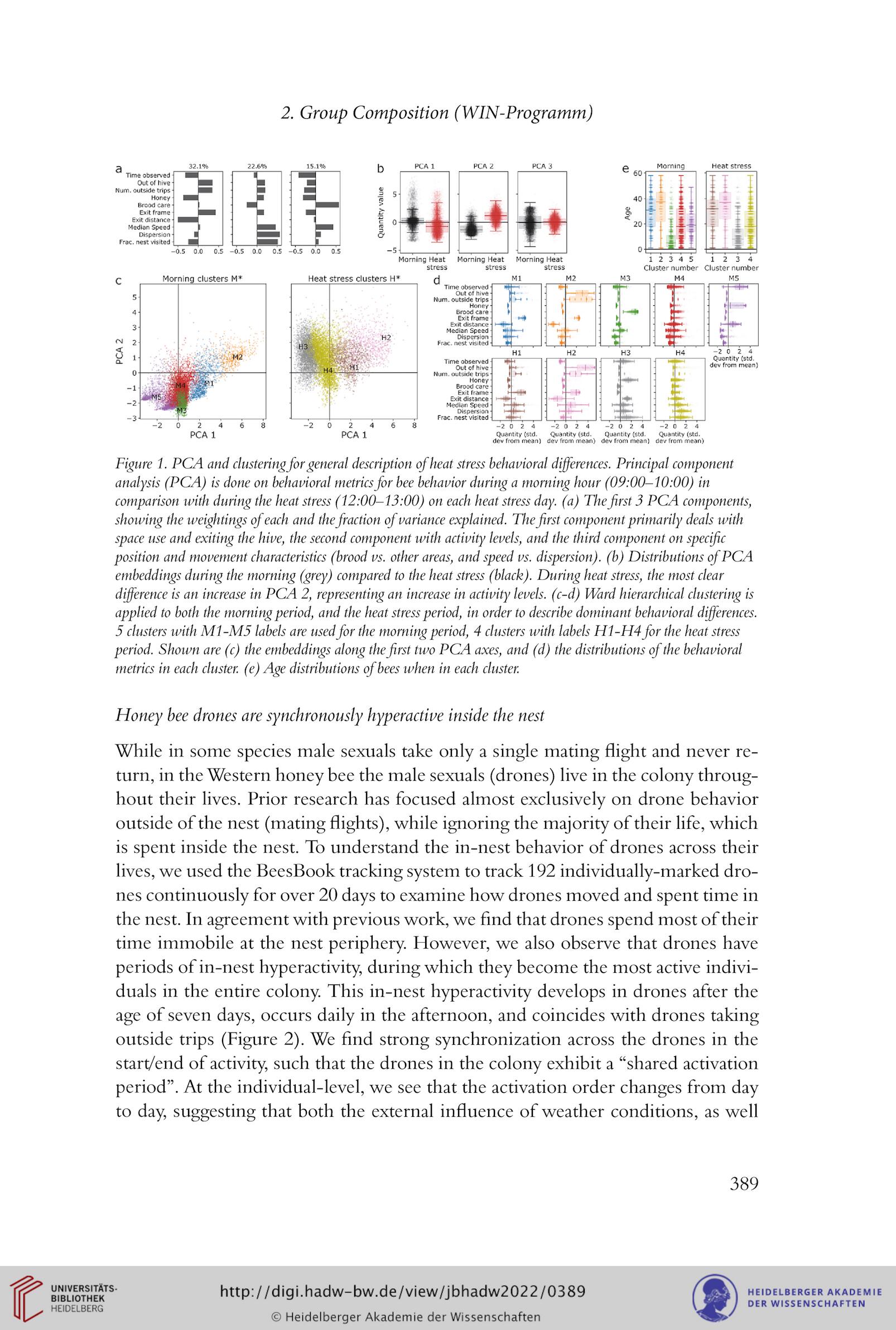2. Group Composition (WIN-Programm)
Figure 1. PCA and clusteringfor general description of heat stress behavioral differences. Principal component
analysis (PCA) is done on behanioral metricsfor bee behavior during a morning hour (09:00-10:00) in
comparison with during the heat stress (12:00-13:00) on each heat stress day. (a) The first 3 PCA components,
showing the weightings of each and thefiraction of variance explained. The first component primarily deals with
space use and exiting the hive, the second component with activity levels, and the third component on specific
Position and movement characteristics (brood vs. other areas, and speed vs. dispersion). (b) Distributions of PCA
embeddings during the morning (grey) compared to the heat stress (black). During heat stress, the most clear
difference is an increase in PCA 2, representing an increase in activity levels. (c-d) Ward hierarchical clustering is
applied to both the morningperiod, and the heat stressperiod, in order to describe dominant behavioral differences.
5 clusters with M1-M5 labels are usedfor the morningperiod, 4 clusters with labels Hl-H4for the heat stress
period. Shoivn are (c) the embeddings along thefirst two PCA axes, and (d) the distributions of the behavioral
metrics in each duster, (e) Age distributions ofbees when in each duster.
Honey bee drones are synchronously hyperactive inside the nest
While in some species male sexuals take only a single mating flight and never re-
turn, in the Western honey bee the male sexuals (drones) live in the colony throug-
hout their lives. Prior research has focused almost exclusively on drone behavior
outside of the nest (mating flights), while ignoring the majority of their life, which
is spent inside the nest. To understand the in-nest behavior of drones across their
lives, we used the BeesBook tracking System to track 192 individually-marked dro-
nes continuously for over 20 days to examine how drones moved and spent time in
the nest. In agreement with previous work, we find that drones spend most of their
time immobile at the nest periphery. However, we also observe that drones have
periods of in-nest hyperactivity, during which they become the most active indivi-
duals in the entire colony. This in-nest hyperactivity develops in drones after the
age of seven days, occurs daily in the afternoon, and coincides with drones taking
outside trips (Figure 2). We find strong synchronization across the drones in the
start/end of activity, such that the drones in the colony exhibit a “shared activation
period”. At the individual-level, we see that the activation order changes from day
to day, suggesting that both the external influence of weather conditions, as well
389
Figure 1. PCA and clusteringfor general description of heat stress behavioral differences. Principal component
analysis (PCA) is done on behanioral metricsfor bee behavior during a morning hour (09:00-10:00) in
comparison with during the heat stress (12:00-13:00) on each heat stress day. (a) The first 3 PCA components,
showing the weightings of each and thefiraction of variance explained. The first component primarily deals with
space use and exiting the hive, the second component with activity levels, and the third component on specific
Position and movement characteristics (brood vs. other areas, and speed vs. dispersion). (b) Distributions of PCA
embeddings during the morning (grey) compared to the heat stress (black). During heat stress, the most clear
difference is an increase in PCA 2, representing an increase in activity levels. (c-d) Ward hierarchical clustering is
applied to both the morningperiod, and the heat stressperiod, in order to describe dominant behavioral differences.
5 clusters with M1-M5 labels are usedfor the morningperiod, 4 clusters with labels Hl-H4for the heat stress
period. Shoivn are (c) the embeddings along thefirst two PCA axes, and (d) the distributions of the behavioral
metrics in each duster, (e) Age distributions ofbees when in each duster.
Honey bee drones are synchronously hyperactive inside the nest
While in some species male sexuals take only a single mating flight and never re-
turn, in the Western honey bee the male sexuals (drones) live in the colony throug-
hout their lives. Prior research has focused almost exclusively on drone behavior
outside of the nest (mating flights), while ignoring the majority of their life, which
is spent inside the nest. To understand the in-nest behavior of drones across their
lives, we used the BeesBook tracking System to track 192 individually-marked dro-
nes continuously for over 20 days to examine how drones moved and spent time in
the nest. In agreement with previous work, we find that drones spend most of their
time immobile at the nest periphery. However, we also observe that drones have
periods of in-nest hyperactivity, during which they become the most active indivi-
duals in the entire colony. This in-nest hyperactivity develops in drones after the
age of seven days, occurs daily in the afternoon, and coincides with drones taking
outside trips (Figure 2). We find strong synchronization across the drones in the
start/end of activity, such that the drones in the colony exhibit a “shared activation
period”. At the individual-level, we see that the activation order changes from day
to day, suggesting that both the external influence of weather conditions, as well
389




